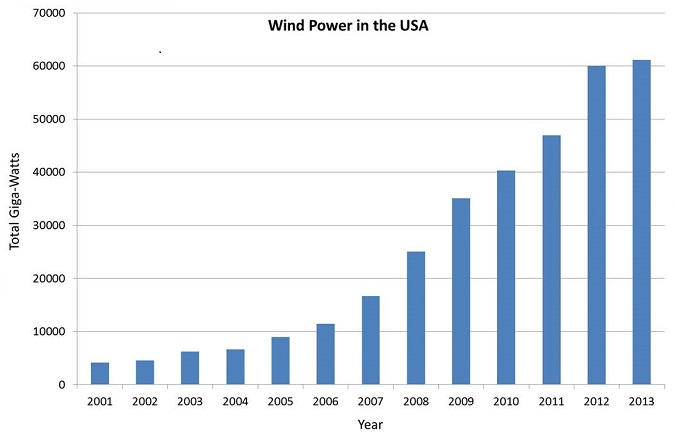The USA, like many other countries around the world, has an interest in the development of renewable energy sources. Wind power is an important feature of the renewable energy landscape in the USA. The increase in wind capacity from 2001 onwards is shown in the figure below [1].

Like any other large-scale construction project, installation of a wind farm has its share of technical challenges and risks. Two issues that are encountered by wind projects are:
- Radar interference
- Television interference
Wind Farm Radar Interference in the USA
Wind turbines are large structures that can interact with radar signals that reach them. Unlike tall buildings (which can also affect radar), wind turbines have fast moving elements which complicates the radar issue further. Particular concerns in the USA include [2] decreased sensitivity, false targets, and corrupted track quality. A simplified overview of these issues is given below.
- Decreased Sensitivity – this means small aircraft that are flying near the wind turbines may not be detected because the turbine itself reflects so much radar energy. An analogy for this issue would be trying to hear someone whispering if they are standing next to someone who is shouting.
- False Targets – this means the wind turbines may show up on the radar screen as targets. The targets are called ‘false’ because they are not caused by aircraft, which is what most radar are supposed to detect. False targets can cause distraction and can even be mistaken for aircraft.
- Corrupted Track Quality – a ‘track’ is shown on an air traffic controller’s screen when an aircraft has been detected by a number of successive radar sweeps (usually three). A track indicates the aircraft’s direction of travel, however these tracks can be displayed incorrectly if the aircraft flies over a wind farm.
Wind Farm TV Interference in the USA
Wind farms have the potential to disrupt TV reception by blocking or reflecting the broadcast signal. This issue can affect both analogue and digital TV. Detailed studies [3] have been undertaken by the International Telecommunications Union (ITU). An overview of the most common issues is given below.
- Failure to receive a picture and/or sound – this can be caused by blocking of the signal by the wind turbine towers. This issue is most likely in cases where the signal was already weak and the wind turbine is constructed between the transmitter and the aerial.
- Intermittent freezing or pixilation of the picture – this can be caused by the spinning rotors interacting with the signal causing fluctuations in signal strength received at the aerial’s location.
Prevention and Mitigation: Radar Interference
In some cases, issues can be prevented by examining the radar constraints at the scoping stage and accommodating them in the layout. This can have consequences for the selected locations and turbine sizes that are selected.
In cases where issues cannot be prevented, mitigation options must be identified and agreed with the relevant stakeholders.
In the case of radar interference, there are various technical mitigation options. Some of these are tried and tested solutions, such as provision of a ‘blanking zone’, while some are much newer. The USA is taking an active role in progressing radar mitigation options.
An $8 million demonstration initiative co-funded by DOE, the U.S. Department of Defense (DOD), the Department of Homeland Security (DHS), and the Department of Transportation’s Federal Aviation Administration (FAA) was undertaken [4]. This was done in order to characterize the impact of wind turbines on current air surveillance radars, assess new technologies for near-term mitigation, and gain a better understanding of the radar-wind interaction issues to enable the development of long-term mitigation strategies.
It has been reported [5] that the DOD/Air Force cleared several projects near the Oregon-Washington State border a few years ago after MIT Lincoln Labs indicated technical improvements could be made to the Fossil Radar in Oregon to reduce clutter.
It was also reported that the DOD/Navy lifted objections to a few projects in South Texas after developers signed memorandums of understanding to help fund mitigation options and potentially to limit turbine operations in certain circumstances if necessary.
Prevention and Mitigation: TV Interference
For television issues, an appropriate layout and site location can ensure there are no impacts. In cases where interference is possible, it is necessary to quantify where this may occur. Technical mitigation options tend to be readily available. However, it is important to understand ahead of time what issues are likely to be encountered and how they can be resolved, as well as determining the likely cost of a solution.
Can we help you?
We have worked helping many wind farm developers with TV interference issues by completing desk based modelling and conducting surveys. Contact us by phone: +44 1787 319001 or email info@pagerpower.com to discuss how we might be able to help you.
References
[1] AWEA (Last Accessed 29/12/2014)
[2] US Department of Energy (Last Accessed 29/12/2014)
[3] See ITU-R BT.2142-1 – The effect of the scattering of digital television signals from a wind turbine
[4] US Department of Energy (Last Accessed 29/12/2014)
[5] AWEA (Last Accessed 29/12/2014)
Image accreditation: “ramsay12” by stallio via Flickr / CC BY-SA 2.0 / Image cropped from original and additional background added.
